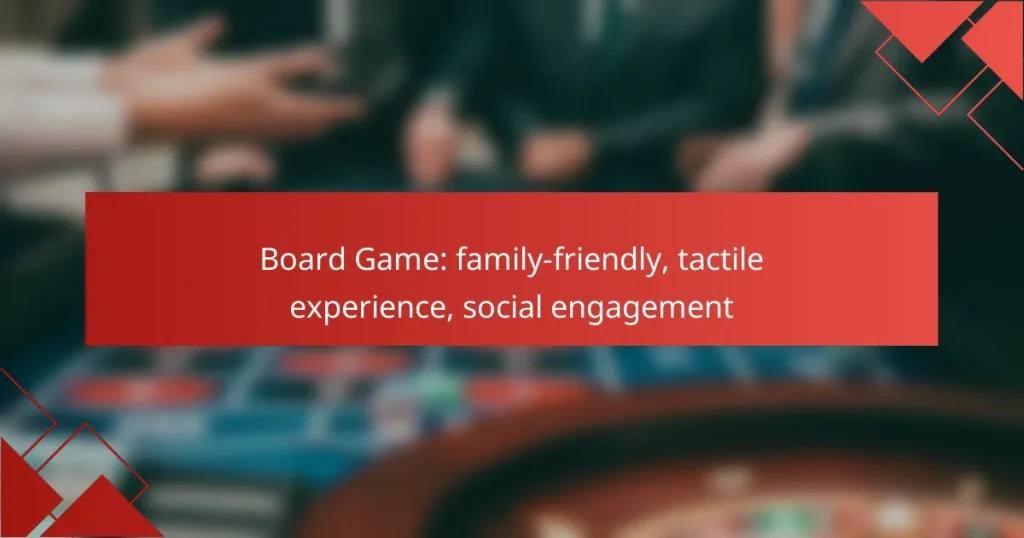Discover the joy of family-friendly board games that combine engaging gameplay with tactile experiences, perfect for players of all ages. These games not only promote strategic thinking and cooperation but also enhance social interactions, making them a fantastic choice for family gatherings and game nights.

What are the best family-friendly board games in the UK?
The best family-friendly board games in the UK offer engaging gameplay, social interaction, and tactile experiences suitable for all ages. These games encourage cooperation, strategic thinking, and fun, making them ideal for family gatherings and game nights.
Catan
Catan is a classic board game where players collect resources and build settlements on a modular board. The game encourages negotiation and trade, making it a great choice for family interaction. A typical game lasts about 60-90 minutes, suitable for ages 10 and up.
When playing Catan, consider the balance of resource distribution and positioning your settlements strategically. Avoid focusing too heavily on one resource, as this can limit your options and trade opportunities.
Ticket to Ride
Ticket to Ride is a railway-themed board game where players collect train cards to claim routes across a map. The game is easy to learn and can be played in around 30-60 minutes, making it perfect for family play. Suitable for ages 8 and up, it fosters strategic planning and competition.
To succeed in Ticket to Ride, prioritize completing your destination tickets while blocking opponents from key routes. Keep an eye on the train card draw pile to anticipate your next moves and adapt your strategy accordingly.
Carcassonne
Carcassonne is a tile-placement game where players build a landscape with cities, roads, and fields. Each turn, players draw a tile and place it strategically to score points. The game typically lasts about 35-45 minutes and is suitable for ages 7 and older.
Focus on completing cities and roads for maximum points, but also consider the potential for placing followers in fields for end-game scoring. Be mindful of your opponents’ placements to block their scoring opportunities when possible.
Azul
Azul is a visually striking tile-laying game where players draft tiles to create beautiful patterns on their boards. The game is quick to learn and lasts around 30-45 minutes, making it ideal for family play. Suitable for ages 8 and up, it combines strategy with aesthetics.
To excel in Azul, aim to complete rows and columns for bonus points while minimizing wasted tiles. Pay attention to your opponents’ boards to anticipate their moves and adjust your strategy to block their scoring potential.
Splendor
Splendor is a card-based game where players collect gems to purchase development cards and earn points. The game is easy to grasp and typically takes 30 minutes, making it suitable for families with children aged 10 and older. It encourages strategic thinking and resource management.
In Splendor, focus on acquiring cards that provide permanent gem bonuses to enhance your purchasing power. Balance your strategy between collecting gems and purchasing cards to maintain a competitive edge while keeping an eye on your opponents’ progress.

How do board games enhance social engagement?
Board games significantly enhance social engagement by creating interactive environments where players communicate, collaborate, and compete. These games foster connections among family and friends, making them ideal for social gatherings.
Encourages communication
Board games require players to discuss strategies, negotiate trades, and share ideas, which naturally promotes communication. This interaction can help improve verbal skills and encourage players to express their thoughts clearly.
For example, games like “Catan” involve players negotiating resources, which necessitates dialogue and persuasion. Such exchanges can lead to deeper conversations and strengthen relationships among participants.
Builds teamwork
Many board games are designed to require collaboration, helping players develop teamwork skills. When players work together to achieve a common goal, they learn to rely on each other’s strengths and support one another.
Cooperative games like “Pandemic” challenge players to strategize as a team to overcome obstacles, fostering a sense of unity. This teamwork can translate into improved collaboration in real-life situations, whether at work or in personal relationships.
Fosters friendly competition
Board games often introduce a competitive element that can enhance social dynamics. Friendly competition encourages players to engage more actively, as they strive to outsmart one another while maintaining a fun atmosphere.
Games such as “Monopoly” or “Ticket to Ride” create a competitive spirit that can lead to laughter and memorable moments. However, it’s essential to keep the competition light-hearted to ensure that all players enjoy the experience without feeling stressed or upset.

What tactile experiences do board games offer?
Board games provide a variety of tactile experiences that enhance player engagement and enjoyment. These experiences include handling physical components, participating in interactive gameplay, and customizing pieces, all of which contribute to a richer social atmosphere.
Physical components
The physical components of board games, such as dice, cards, and game boards, create a tangible connection between players and the game. Handling these items can evoke sensory responses, making the experience more immersive. For instance, the weight of a well-crafted game piece or the texture of a card can significantly enhance the overall enjoyment.
When selecting a board game, consider the quality of its components. Games with durable materials often withstand repeated use, making them a better investment for family gatherings. Look for games that include a variety of components to keep the tactile experience diverse and engaging.
Interactive gameplay
Interactive gameplay in board games encourages players to engage with each other physically and socially. This interaction often involves passing pieces, rolling dice, or moving tokens, which fosters a sense of community and collaboration. Games that require teamwork or competition can heighten these interactions, making the tactile experience even more impactful.
Choose games that promote active participation. For example, games that involve simultaneous actions or require players to physically reach for components can create a lively atmosphere. Avoid games that rely heavily on passive observation, as they may diminish the tactile engagement.
Customizable pieces
Customizable pieces in board games allow players to modify their experience, adding a personal touch to the tactile interaction. This can include adjustable game boards, personalized tokens, or even player-created rules. Such customization not only enhances the tactile experience but also encourages creativity and investment in the game.
When looking for customizable games, consider those that offer expansion packs or additional components. This flexibility can keep the game fresh and engaging over time. Be cautious of overly complex customization options that may detract from the core gameplay experience; simplicity often leads to better engagement.

What criteria should you consider when choosing a board game?
When selecting a board game, consider factors such as age appropriateness, player count, and game duration. These criteria ensure that the game is enjoyable and suitable for your group, enhancing the overall experience.
Age appropriateness
Age appropriateness is crucial when choosing a board game, as it affects both engagement and understanding. Games designed for younger players often feature simpler rules and themes that resonate with children, while those for older audiences may include more complex strategies and mature content.
Check the recommended age range on the game box or description. For family-friendly options, look for games suitable for ages 8 and up, as they typically balance fun and challenge for a wide audience.
Player count
Player count influences the dynamics and enjoyment of a board game. Some games are designed for small groups, while others accommodate larger gatherings. Consider how many people will typically play together to ensure everyone can participate.
Many games specify an optimal player range. For instance, games that support 3-6 players can be ideal for family gatherings, while those designed for 2 players may be better for couples or close friends.
Game duration
Game duration is an important factor that affects how much time you can dedicate to playing. Shorter games, typically lasting 20-30 minutes, are great for quick sessions, while longer games may take 1-2 hours or more, suitable for dedicated game nights.
When choosing a game, consider your group’s attention span and schedule. If time is limited, opt for games that can be completed in under an hour to keep everyone engaged and avoid fatigue.

What are the emerging trends in board games?
Emerging trends in board games focus on enhancing player engagement through eco-friendly materials, digital integration, and themed experiences. These trends reflect a growing desire for sustainability, technology incorporation, and immersive gameplay that appeals to diverse audiences.
Eco-friendly materials
Board game manufacturers are increasingly using eco-friendly materials to appeal to environmentally conscious consumers. This includes recycled paper, biodegradable plastics, and sustainably sourced wood. Choosing games made from these materials can reduce environmental impact and promote sustainability in the gaming community.
When selecting eco-friendly games, look for certifications such as FSC (Forest Stewardship Council) or similar labels that indicate responsible sourcing. Many companies are now transparent about their production processes, making it easier for consumers to make informed choices.
Digital integration
Digital integration in board games enhances the tactile experience by incorporating apps or online platforms that complement physical gameplay. This can include features like augmented reality, digital scorekeeping, or interactive tutorials that streamline learning. Such integration can make games more accessible and engaging, especially for younger players.
When considering digital integration, check for compatibility with devices and whether the app is free or requires a purchase. Games that offer a seamless blend of physical and digital components can provide a richer experience, but ensure that the technology does not overshadow the core gameplay.
Themed experiences
Themed experiences in board games create immersive worlds that draw players into unique narratives or settings. Popular themes range from fantasy and sci-fi to historical events and popular culture. These themes can enhance social engagement by fostering discussions and shared experiences among players.
To choose a themed game, consider the interests of your group and the level of complexity desired. Many games come with expansions that further develop the theme, allowing for deeper exploration and replayability. Look for games that offer a strong narrative and character development to maximize the thematic experience.


